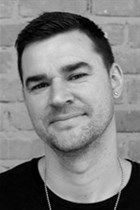






Even now as a creative I've fallen into the trap of trying to find something that makes my creative voice "unique" rather than letting who I am create it. The idea of being criticised or not liked socially is something that has completely changed the way we view ourselves and has sometimes even made me question my ability as a designer. However, should it? Should I not be challenged by it? Should I care what other people "like" about me? I believe as a creative I should be challenged by this concept, to let my artistic communication be real and authentic to my character rather than play into the idea of wanting to be liked.
In our lives, we encounter numerous personalities or characters that either affects us positively or negatively. Their character could make us happy, encourage us, bore us or bring us down. However, what matters out of all of this is that we are comfortable with the character we are putting into the world.
This form of internal identifying is what brand and design agencies have to do for clients every day. It is vital in building an authentic personality for brands. Often clients want something like XYZ's brand, the cool looking brand or the "out there" brand, the one that everyone loves rather than investing time and money into developing a character for who it is as a business and what it stands for.
For myself, I would say I'm reserved, and happy-go-lucky. But a small part of me is a little out there and quirky. Not everyone gets to see this side of me, only close friends and family, although it can be seen subtlety in the way I dress. I wouldn't say I'm your stereotypical looking creative, but there is one item I wear which signifies that little part of me that wants to stand out and it comes through in my sneaker obsession. Adidas sneakers to be exact. From polka dotted ones to a blend of camo and pink, and even reflective shock mint sneakers, the list goes on. The pursuit for a variety of sneakers gives me the ability to express how I am feeling each day in my footwear. This part of my personality is probably not unique, but it's authentic, and if I were a brand it would be part of my visual story.
In the past ten years, I have come to love the process of creating word marks and identities for brands and believe brands should have an authentic mark or typeface, and a visual language to express its voice and personality. This visual interpretation should liberate brands and help them speak in a tone that suits its character.
The character of each brand is what helps it communicate to the people it wants to reach. People view brands the same way they do people. The character (or personality) of a brand determines whether it deserves our attention, and it is then the consumer's choice whether to engage with a brand based on how it makes them feel.
The above goes hand in hand with the nuances in each letter in a logo or the visual language the graphic shapes speak. It is what builds character. A good example of this is Spotify. The brand launched with a logo which would suit a cellular or tech network. Collins, a design agency was commissioned to evolve the brand's visual language to make it feel more like its core character of a music entertainment brand. The logo didn't change much, but the brand's visual personality and voice went from being relatively static to exuding energy and dynamism, capturing the different ways in which music makes us feel.
This was expressed in various graphic forms and visuals, giving the viewer a sense of the artist’s intentions and helping the audience connect emotionally with the music available. This is an excellent example of how visual language can set a new tone for a brand communication and get people to want to engage with its personality and voice.
Many prospective clients don't always understand the value in developing truly authentic brands. Our human nature is to go with what is comfortable, and what we feel happy with, not leaving it up to interpretation or letting an audience navigate its way around a brand. Although we don't want to fight with clients who often have passionate views about their brand, we should not fold under pressure and give in to every request if we believe it's not right. Creatives need to be invested in making a brand's story come alive and deliver a sustainable personality, and the ability for a character and voice to connect and evolve with an audience.
Nowadays, I do feel our job as designers has become harder due to the excessive number of brands out there. Often when brainstorming brand marks and shapes within an idea, I cross-check online for anything that looks similar before going any further. More often than not, you will find something which shares a resemblance. It has become harder to find new shapes and icons to put together and form a brand mark.
What I suggest is that we find ways of building and putting together shapes and marks that are faithful to the brands we are developing. Strive for authenticity in a brands voice rather than trying to make them completely different for different sake. The process of identifying a graphic route which is real to each brands story will often lead us to a solution which is better and that stands out more. So, the aim of this is for us as designers and for brands themselves to target what’s true, so they can get real insight and the ability to grow from a place that is authentic and meaningful.
As the sentiment goes, "as much as we may think we are cooler or better at something than anyone else there will always be someone who is far greater." This is the same for brands. There will always be someone with more money or resources to do a better job; therefore, it is prudent to stick to what is the most authentic and real, to let the core character stand proud, giving room for a brand's identity to flourish and connect with its consumers. Hopefully, by doing this as designers, it will enable us to advise our clients that their brands should too.
